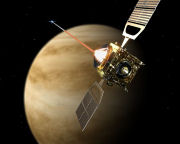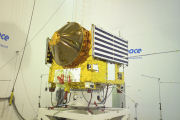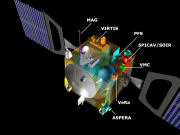 |
 |
 |
 |
| Missions
|
||
         |
Venus
Express Venus Express is the first Venus exploration mission of the European Space Agency. Launched in November 2005, it arrived at Venus in April 2006 and has been continuously sending back science data from its polar orbit around Venus. Venus Express is a satellite optimised for studying the atmosphere of Venus, from the surface right up to the ionosphere. Since its arrival at Venus, Venus Express had been on an elliptical 24 hour orbit, travelling 66 000 km above the south pole at its furthest point and to within 200 km over the north pole on its closest approach, conducting a detailed study of the planet and its atmosphere. Venus Express used the same design as the Mars Express mission and the same industrial teams that worked on that mission. The Venus Express spacecraft is a virtual twin of Mars Express. The spacecraft body itself, termed a ‘bus’, is a honeycomb aluminium box about one and a half metres wide. With its solar arrays extended, it measures about eight metres across. As for Mars Express, the scientific instruments are mounted in the bus. It also borrowed instrument technology from Rosetta. Instruments of orbiter:
20.December
2014
|
 The VenusExpress at Venus (artist's view)  The VenusExpress in Baykonur  Instruments on the VenusExpress |